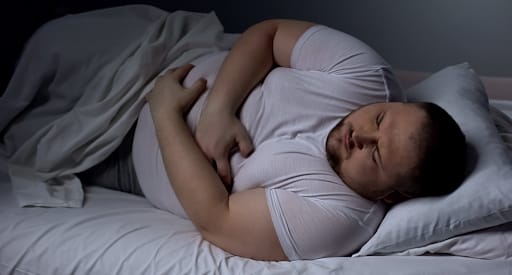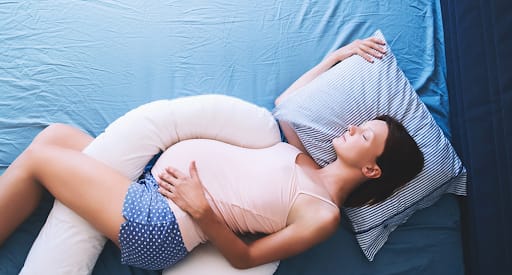Testing a mattress for free before trying it out is a fantastic opportunity. Here’s how you can try out online mattresses in person before buying.
Blog > Right Side Sleeping Poses Health Risks, According to Chiropractors 2024
Blog > Right Side Sleeping Poses Health Risks, According to Chiropractors 2024
Even though researchers have established multiple benefits of side sleeping, many recent studies show that experts are advising people to shift to their left side while resting and avoid right side snooze.
One might wonder, “how in the world would sleeping on the right threaten my health?”
Let’s explore the reasons behind this claim.

Sleep Positions cause pain
We do know that resting on a good mattress can positively impact overall health. However, sleep positions also play a unique role in improving how you snooze.
Chiropractors believe your sleep style determines how the body eliminates the internal gunk and relieves pain from pressure regions.
As you spend about eight hours in whichever position you assume every night, you should know whether or not it is promoting wellness.
More than 50 million Americans suffer from some sleep disorder due to irregular resting patterns and consistent sleep deprivation. One of the contributing factors in these alarming statistics is resting in an improper sleep position.
If you regularly sleep in a bad pose, it can lead to increased excruciating pain development and restless nights.
A wrong pose can trigger acute or chronic pain in main pressure areas — such as shoulders, upper and lower back, hips, and neck. As a result, the quality of snooze gets severely affected.

Chiropractors want you to avoid right side position
Additionally, research published in the Australian Journal of Physiotherapy indicates that typically elderly folks who rest in an improper posture suffer from severe cervical stiffness, cervical pain, and headaches uponwaking up.
Here’s an overview of their findings based on age and gender factors.
| Arm/shoulder pain | Cervical stiffness | Cervical pain | Headaches | |
|---|---|---|---|---|
| Percentage (%) of people who woke up with pain | 27 | 17 | 18 | 19 |
| More common age group/gender | 60+ years (Male/Female) | 40-59 years (Male) | 40-59 years (Male) | 40-59 years (Male/Female) |
It is evident that if you fail to be mindful of your sleep style, as you age, the practice might pave a path for enhanced pressure points in sensitive areas.
Most of the people experiencing pain show reduced REM sleep (commonly known as deep sleep) because of frequent disturbances during slumber.
Imagine — not only resting on a bad mattress but also in a weird pose. You’ll spend most of your time tossing and turning in the bed. Hence, when you wake up in the morning, you’ll be tired and achy — as if you never slept! The duration of snooze shortens and thus, daytime sleepiness increases.
Scientists emphasize on assuming a correct sleep posture during the night as it impacts neck and shoulder muscles. Increased pressure on these two areas leads to acute pain development — which if not treated, might turn chronic.
However, many people who tend to sleep in a proper position – other than prone (tummy sleeping) – report fewer instances of pressure development in the back, shoulder and other sensitive regions.
Besides, appropriate pose allows sufficient blood flow to all internal organs and aids waste eliminating processes. This further improves your overall rest quality as you experience limited to no interruptions while slumbering.

Proper sleep style leads to refreshing slumber
Your sleep style will benefit your body even more if you choose a suitable mattress and pillow complementing the weight and firmness preferences. Both things work together to make your sleep experience relaxing and eases tension from pressure points.
Hence, when you wake up after an undisturbing and rejuvenating slumber, you’ll be more productive and perform better in your routine tasks.
According to survey statistics conducted in 2017, 36% of the Americans are left side sleepers whereas 34% rest on the right.
All in all, over 60% of the population in our country opts for side snooze position — that too for a good reason!
Sleep experts consider this pose as one of the safest and most beneficial for our body. There are numerous benefits to your overall health if you lie down on the sides.
For example, over a million US adults suffer from CTS (Carpal Tunnel Syndrome) — a condition causing numbness and tingling in arms. The condition may worsen during sleep if one assumes a bad posture.
According to a 2016 study published in Plastic and Reconstructive Surgery Global Open, lateral sleep positions decreased instances of numbness in CTS patients.
Besides, studies show that sleeping on the sides help with waste elimination and facilitates metabolic activities involving the removal of toxins from the brain and other vital organs. Experiments reveal this position potentially reduces the risk of Alzheimer’s and Parkinson’s disease.
Side sleeping is also beneficial for your back. You get excellent spine alignment when laying on left or right, as it limits pressure point formation. If the curve between the mattress surface and lower back is appropriately cushioned, it helps prevent lower back pain issues.
Recent researches show increased inclination toward left-side slumbering. Sleep scientists and chiropractors are warning against the silent hazards of rightie snooze posing serious threats to human health.
Following are some of the negative impacts of sleeping on your right side.

Ugh...GERD worsens if you’re a right sleeper
According to a 2000 study published in the American Journal of Gastroenterology, right side slumber may trigger acid reflux/ GERD (Gastroesophageal reflux disease). On the other hand, shifting to your left can alleviate the condition.
After conducting an experiment on ten healthy individuals who had eaten a heavy meal, scientists discovered gastric activity – particularly acidity – alarmingly enhanced among right lateral sleepers, compared to those who were on the left side or in a supine position.
The reason behind it is quite straightforward. Because of the limited space on the right side, the tummy curve affects food digestion due to enhanced abdominal pressure. Thus, it triggers heartburn.
Usually, heartburn is common among males who are aged over 30 — particularly those who are also obese. If not treated, the disease can grow into BE, a form of esophageal cancer.
Therefore, chiropractors advise you to sleep on the left side to avoid frequent sleep disruptions due to GERD discomfort.

Blood circulation gets affected
Among the various cons of right side slumber, is decreased blood circulation. Even though the human heart is positioned on the left side, ironically, you get excellent circulation to all vital organs when you’re sleeping as a leftie.
The heart pumps blood to organs and receives it back through a network of arteries and veins. If you lie down on your left, your right side is not squeezed/compressed, leaving ample room for the blood vessels to carry out smooth blood flow functions, explains a Virginia-based sleep specialist, W. Christopher Winter.
Thus, listen to the chiropractors and switch to your left next time, so you get efficient blood supply while snoozing.

The right side in pregnancy is left
If you’ve had a baby, you might already know that experts recommend not to lie down on your back during the late days of pregnancy.
This is because the fetus activity drops when you’re in the supine form — thus increasing the chances of stillbirth!
An Auckland study studied the heart rate of fetuses when the soon-to-be-moms were lying on their back and sides. They found the fetal heart rate improved when the ladies were in lateral position.
However, another study linked sleeping on the right side to the same dangers. Researchers found that the risk of stillbirth among left side sleepers was 1.96 per 1000 births — whereas right side sleepers experienced fetal stillbirth in 3.39 deliveries out of 1000.
One of the reasons explained by Tomasina Stacey, a midwife in Auckland, was the reduction of blood flow to the fetus because of the sleep position impact on blood circulation. Because of the arterial compression, there is a risk of affecting the blood supply to baby’s organs.
That’s why chiropractors advise pregnant women who have reached the third trimester to shift to the left side while resting.
You can also purchase a suitable mattress and pillow to suit the body shape changes during pregnancy and avoid back pain issues.

Right side causes spine alignment problems
Believe it or not, chiropractors have linked right side sleeping to back or neck pain development.
According to experts, shifting to your right puts pressure on the spine, making it difficult to maintain the natural curve of the vertebra. And since the blood circulation is also affected while you’re on the right side, it certainly leaves an impact on the back.
If you are already suffering from severe pain in the lumbar region, you should prop a body pillow to support your weight and protect the spine shape. Some people also use a wedge pillow between the knees, but it’s not as useful as a body cushion.

Chiropractors also recommend sleep apnea patients to ditch right side slumbering for their own good. Surprisingly, the throat and tongue is likely to be better adjusted while you’re on the left, compared to the opposite side.
Researchers are confident that with the perfect mattress and pillow combination, along with the left side position, sleep apnea can be completely eliminated.
It’s pretty much evident from recent studies that sleeping on your right side may not be as beneficial for your health as you’d expect. So take your chiropractors’ advice next time and try switching the posture a bit to enjoy a good night’s sleep!

 Showrooms
Showrooms
About The Author
Dustin Morgan
Sleep Expert & Store Manager
Dustin Morgan is the Chief Mattress Analyst and Sleep Technology Expert at SleePare. He combines his computer science background with his passion for sleep innovation. With personal experience testing over 200 mattresses, Dustin offers unmatched insights into finding the perfect sleep solution for various needs. His work focuses on delivering honest and detailed comparisons and advice to help individuals achieve their best sleep. When he is not exploring the latest sleep technology, Dustin enjoys spending time in the great outdoors and gaming in his Virginia home.